
A stakeholder is a person or organization which as an interest or concern in a given goal, business case or assignment. Stakeholders have a vested interest in the success of assignments, which can affect the stakeholder positively or negatively. A stakeholder may use their influence to promote and help an assignment succeed, or hinder the success of an assignment if the resulting architecture is negative for the stakeholder. Some stakeholders may play an active part by contributing to the initiative, while other stakeholders play a more passive role.
Examples of typical stakeholders are customers, executives or company departments.
Why are stakeholders important
Stakeholders are important as they influence the progress of an assignment and in some cases can make the difference between success and failure. Different stakeholders have varying degrees of influence and needs for information.
“You can please some of the people all of the time, you can please all of the people some of the time, but you can’t please all the people all of the time”
Poet John Lydgate as made famous by Abraham Lincoln
Managing stakeholders can take a lot of effort, and where an assignment has a great many stakeholders this can be very challenging. Ensuring that influential and key stakeholders are satisfied, substantially increases the chances of an assignment’s success.
Having key stakeholders as a positive influence on an assignment can deliver significant advantages such as, access to funding, availability of key personnel or increased priority over other initiatives.
In some cases, a stakeholder may be key, but is affected negatively by the assignment or the proposed architecture. For example, when replacing a legacy system, the owner of the legacy system may be key for migrating data, however migration to a modern system may leave the stakeholder with less power or budget. In this case it is important to find ways to mitigate the negativity, perhaps by making compromises in the architecture, such as a favorable re-organization or a change of roles.
Stakeholders Approach
The following are some key principles which can help in managing stakeholders.
Opinions matter
Stakeholders will want to influence the direction of an assignment in their own favor, and one way of doing this is sharing their opinions with the architect. Taking opinions on-board from stakeholders can create a “buy-in” for the assignment, and this can increase the stakeholder’s interest in the assignment succeeding.
Stakeholders may have conflicting opinions and with many stakeholders it is challenging to give all opinions the same attention. Choices may have to be made as to which opinions are satisfied and which are given less attention. This is where it is important to know which stakeholders hold the most favor for the assignment (see The Power-Interest Grid).
What drives the stakeholder
Interest or concern from a stakeholder is born from a driving factor. The driving factor is the force which drives the stakeholder interest and influences decision making. For individual persons driving factors may be: prestige, power, stability, skills advancement. For an organization the driving factors can depend on the organization culture and the type of business the organization conducts. Examples of driving factors for organizations are: growth, increase budget/sales, access to skills, compliance, competitive advantage.
Knowing what drives the stakeholder makes it easier to promote an assignment to the stakeholder, and show how the stakeholder can gain value from the architecture. The driving factors of the stakeholder give a basis for assessing the stakeholder interest for the various aspects of the architecture. Understanding what drives the stakeholder makes it easier to promote an assignment and the architecture, as well as showing how the stakeholder can gain value.
Managing stakeholders requires balance
Stakeholders have complex relationships with each other, and to gain influence and interest from a stakeholder trust is key. This can be a delicate balancing act as a commitment to one stakeholder may have a negative effect on the relation with another stakeholder. Negotiation, diplomacy and conflict management are useful skills in achieving balance in the architecture and maintaining the trust of the stakeholders.
The available effort for managing stakeholders is not limitless, and focusing on a narrow band of stakeholders may keep a few important stakeholders satisfied. However, this can lead to problems with the broad spectrum of stakeholders who may lose interest in the assignment or start a negative trend towards the architecture. It is therefore important to find the right balance in managing the effort expended on stakeholders
Identify key dependencies
In some cases, specific stakeholders are critical for the success of the assignment. It may be the case that a stakeholder holds special skills, resources or is responsible for other projects/products which the assignment is dependent on. Identifying the key dependencies between activities in the assignment and such stakeholders is essential to the success of the architecture.
Know the audience
When communicating the architecture, it is important to ensure that the architecture is presented in a way which the stakeholders understand. Stakeholders often come from different backgrounds and have different interests in the architecture. For example, some stakeholders may have an interest in the technical perspective of the architecture, while other stakeholders are interested in the business perspective. Selecting the right architecture viewpoints for the right stakeholders ensures that the information is relevant and increases the understanding of the architecture.
Shareholders Over Stakeholders
Stakeholders may have strong opinions but it is the responsibility of the architect to challenge these opinions and select an appropriate way forward. Opinions and proposals all need to be tested with different scenarios and situations to gain the best outcomes. This provides the architect with the motivation for a proposed change, and gains the respect of the stakeholders rather than simply following stakeholder instructions.
Managing the stakeholders in practice
Managing stakeholders in practice is about maintaining the right balance in stakeholder motivation with reference to the objectives of the architect. The following sections provide a description of some tools which can help the architect analyze stakeholders and decide how best to manage stakeholders.
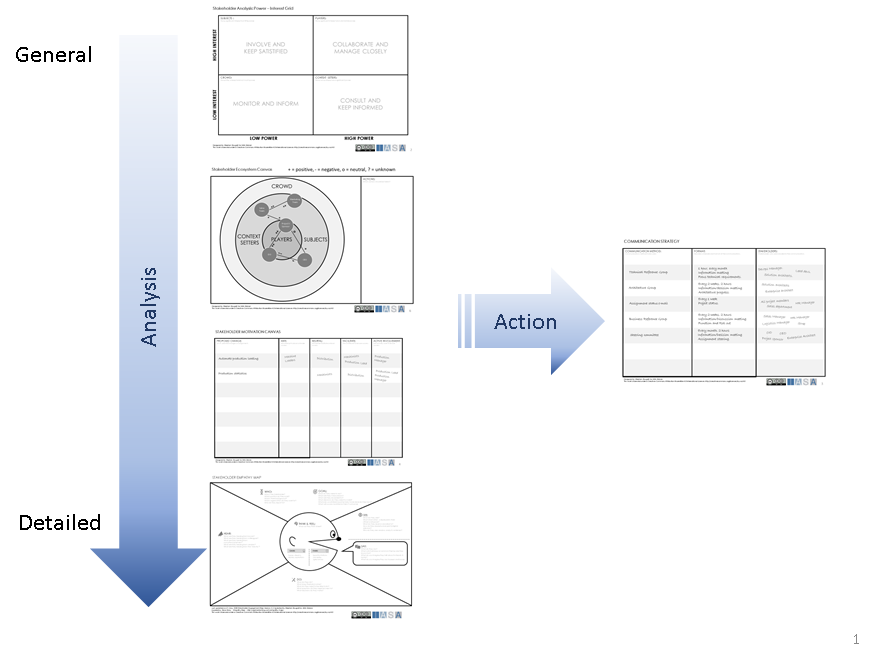
These can be used in many different scenarios. The diagram above shows when these tools can be used to support the management of stakeholders.
When working with stakeholder management we can consider our analysis of stakeholders on a scale of general to detailed, where the general end of the scale considers a broad scope of stakeholders and the detailed end of the scale considers individual stakeholders. In the following section, tools are provided for management of stakeholders from general analysis through to detailed.
After analysis, actions need to be taken to actively manage the stakeholders. The communication strategies tool provides a way for planning the action.
Identifying and prioritizing Stakeholders
The first step in stakeholder management is to identify the stakeholders in the assignment or the proposed architecture. A good way to start identifying and prioritizing stakeholders is to use the Power-Interest Grid. The motivation behind identifying and prioritizing the stakeholder is that it gives a basis from which the architect or the team can begin to plan how to manage the stakeholders.
The Power-Interest Grid can be used either with a team in workshop format or individually. Working in workshop format will probably provide better results as a team can identify a broader range of stakeholders and give a collective view of where the stakeholders belong on the grid.
When working in workshop format the Power-Interest Grid should be pinned to a wall or drawn on a whiteboard. The workshop should have a focus context for the stakeholders, such as an assignment or even a particular aspect of the architecture. All participants should be well versed in the context before starting the workshop. The following method can be used with participants in workshop format.
Step 1: Identify the Stakeholders
Handout sticky notes to the participants and ask them to write down all stakeholders they can think of concerning the given context (one stakeholder per sticky note). This exercise should be time bound, usually 10-15 mins. The participants should do this without conferring with each other.
Step 2: Prioritize the stakeholders
Ask each participant to place the stakeholders on the Power-Interest Grid according to the perceived interest and power of the stakeholder.
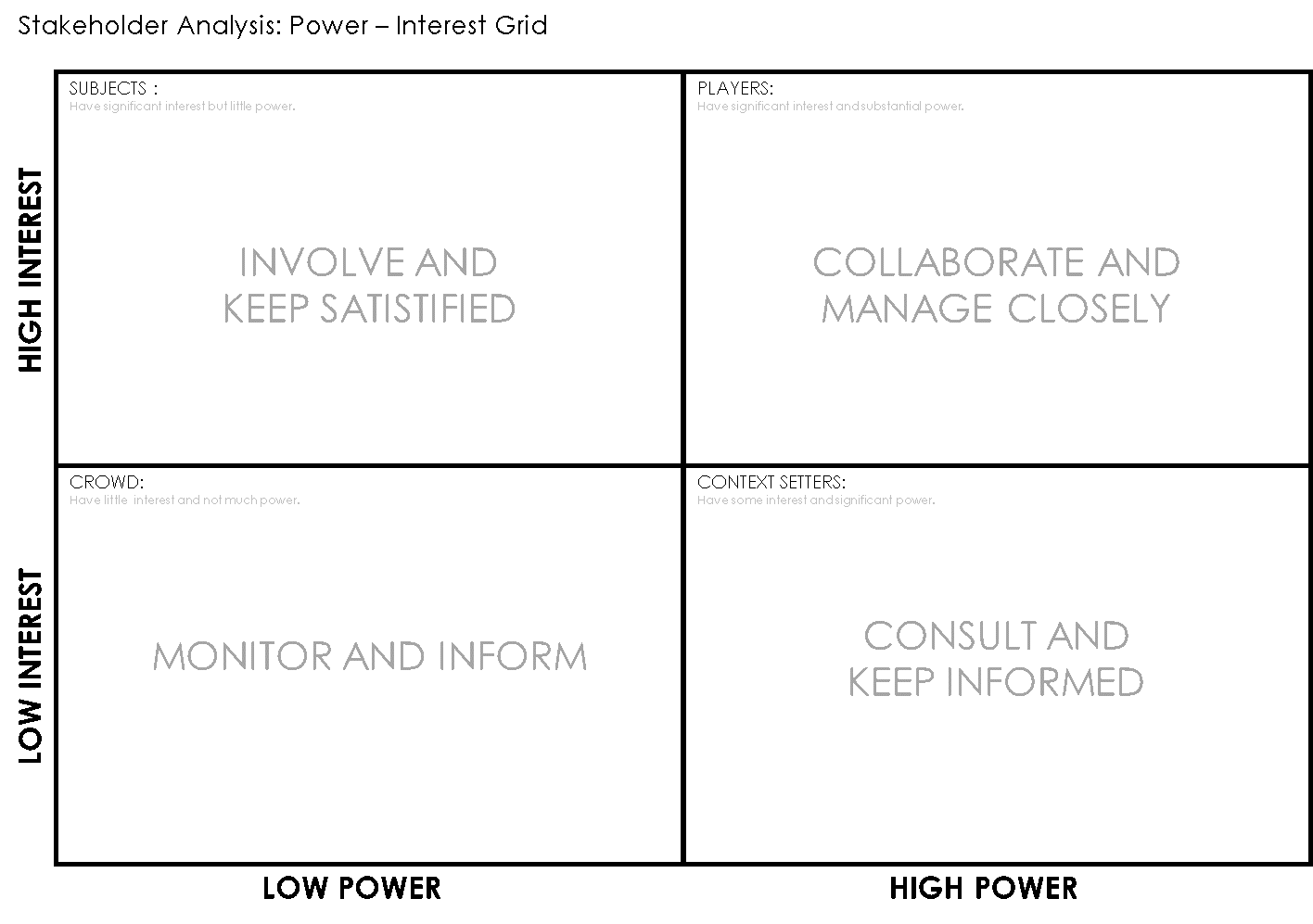
Step 3: Reach consensus
Participants then discuss the stakeholders and adjust them so they fall into the right place on the board. It may be that several participants have placed the same stakeholder in different places on the board, or that there are different opinions about the priority of stakeholders on the board. Reasons for the prioritization can be discussed and stakeholders adjusted appropriately to positions on the board which the participants agree on.
The result of the workshop is that stakeholders can be prioritized into the following categories:
- Crowd – these are stakeholders which have a low interest and a reduced ability to influence the context. It is recommended to keep these stakeholders informed with general information and periodically monitor that their needs are fulfilled.
- Subjects – these are stakeholders with a high level of interest but with little power to influence the context. They need to be kept informed of any major issues and their concerns should be listened to. They can be a great help in promoting the context to other stakeholders.
- Context Setters – these stakeholders have a high degree of power but a low level of interest. They should be kept informed with relevant information and may be consulted about significant decisions as they can help with their influence.
- Players – these stakeholders are high priority and are the key players in the given context. They require close management and should be actively involved in the context. They hold the power to influence the context and require regular information updates.
Once the stakeholders are prioritized a communication strategy can be developed to help satisfy the stakeholder information needs. Important stakeholders may be selected for further analysis using tools like the Empathy Map or the Stakeholder Motivation Canvas.
Stakeholder Ecosystem
No stakeholder is an island, the stakeholders associated with an assignment or architectural change have relationships which are often complex. The stakeholder ecosystem describes how stakeholders are related to each other and the nature of the relationship. Within the ecosystem the architect team can also be considered as a stakeholder.
The stakeholder ecosystem is important for the architect as it provides an understanding of how a change in stakeholder motivation affects other stakeholders, and can also provide a way to assess how to motivate groups of stakeholders. For example, if we have a stakeholder who is held in high regard by three other stakeholders, then positively motivating that stakeholder will likely motivate the other three stakeholders too. It is also likely that these stakeholders may work well together in a reference group.
The Stakeholder Ecosystem Canvas provides a way to analyze the stakeholder ecosystem and propose actions which can be taken to manage stakeholders. This canvas can be used as an individual tool or with teams in workshop format. The following method can be used in workshop format:
Step 1: Decide the scope of the ecosystem
Before starting the workshop, the participants should agree on the scope of the ecosystem. The scope may be, for example, an assignment, an architectural change or a particular organization. Defining the scope will ensure that focus is placed on a specific set of stakeholders.
Step 2: Decide the context of the ecosystem
The context of the ecosystem is described in the rings on the canvas. In the example canvas the chosen context is “Power-Interest” taken from the Power-Interest Grid, this provides a visualization of the importance of the stakeholder. However, the canvas can be used in other contexts, such as organizational, roles-based or motivation categories (see Stakeholder Motivation).
Step 3: Place the stakeholders in the right context
Ask the participants to write down the relevant stakeholders for the scope on sticky notes. Then each participant should place their stakeholders on the canvas in the appropriate context category. If participants have placed the same stakeholder in different context categories the participants should discuss and agree upon the correct context category for the stakeholder.
Step 4: Map the relationships between the stakeholders
After placement of the stakeholders, each participant should take turns in connecting the stakeholders with relationship lines. At this point the participants only need to indicate that they are aware that a relationship exists between stakeholders.
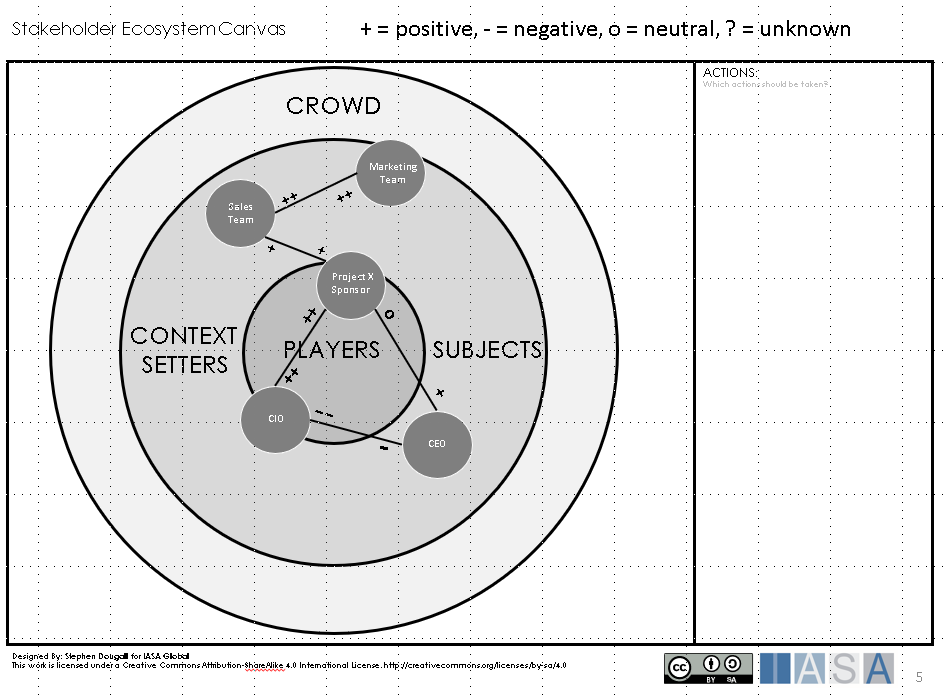
Step 5: Assess the relationships
Once the relationships have been drawn on the canvas the participants should first make a simple assessment of the relationships. For each relationship on the canvas an assessment can be made from each stakeholder perspective. A stakeholder may have a positive relationship (+), a negative relationship (-) or a neutral relationship (o) to the other stakeholder. This is indicated by placing these symbols next to the stakeholder end of the line. Up to three + or – symbols may be used to indicate the degree of the positivity or negativity. For example, the Sales Team and the Marketing Team in the example canvas have a really good relation. However, the CIO and the CEO have a negative relation, where the CIO is more negative than the CEO.
Once the assessments have been made the participants can also add text to the relationship which explains the nature or reasoning behind the assessment. For example, the CEO may have cut the CIO budget, or they simply just do not get along.
Step 6: Agree on actions to be taken
Once the relationships have been assessed the participants have a clear view of the stakeholder ecosystem. The participants can discuss ways of managing the stakeholders and consider the effect of actions on the ecosystem. From the example canvas we may consider: Should the architect support a CEO proposal? Are there compromise actions to keep both CEO and CIO happy? Can the Project X Sponsor act as a mediator?
Participants can note actions which should be taken on the canvas with respect to the agreed scope.
Stakeholder Motivation
Stakeholder motivation helps in understanding the status of stakeholders in respect of a particular set of proposed changes. This can be used to understand how stakeholders position themselves in relation to a portfolio of assignments but it can also be used to assess how stakeholders will react to proposed changes in the architecture, and assess if these changes are feasible.
When working with a team the Stakeholder Motivation Canvas can be used in a workshop to help map out the stakeholders and their positioning to proposed changes. The following method can be used:
Step 1: Set the scope of change
Before calling the workshop agree on the general subject for change with the participants. Pin the Stakeholder Motivation Canvas to the wall or use a whiteboard. Then list the proposed changes associated with the subject for change. Gain general agreement from all participants that this is the scope of change.
Step 2: Identify the stakeholders associated with the changes
Give each participant a set of sticky notes and ask them to write down the stakeholders associated with the proposed changes. A single stakeholder can be associated with more than one of the proposed changes. Also ask the participants to think about how the stakeholder is currently positioned to the proposed change.
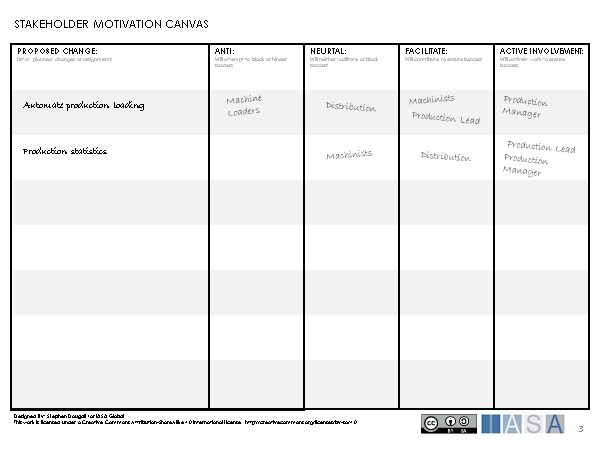
Step 3: Position the stakeholders
For each proposed change ask the participants to place the stakeholders on the canvas in the motivation category most suited to the current position of the stakeholder. In some cases, different participants will place the same stakeholder in different categories. The participants should discuss the positioning and eventually agree on the most suitable position.
The result of the analysis can provide a basis for selecting which proposed changes are most acceptable for the stakeholders, or an indication of which stakeholders require attention to make a proposed change more acceptable. Stakeholders which require attention may be the subject for further analysis, for example, using an empathy map.
Empathy Map
Sometimes the architect may find that certain stakeholders have great influence over the assignment and that it is particularly important to gain positive motivation from the stakeholder. In other cases, a stakeholder may be negative to the assignment and analysis is required to assess how the stakeholder can be motivated to a positive position.
An empathy map is used to gain deeper insights into a particular stakeholder so the architect can empathize with them and better understand their position. This analysis of the stakeholder will give the architect a better understanding of how to engage and motivate the stakeholder.
The empathy map can be used as an individual or by a team of participants. The following method can be used:
Step 1: Gather information
Gather factual information about the stakeholder:
- Who – a description of the stakeholder, role, interests, organization.
- Goal – a description of what the stakeholder is required to do, objectives, targets, successful outcomes.
Step 2: Set the context
Set the context by asking the stakeholder a question often related to what are the participants trying to achieve. For example, “Why should I replace the business system?” or “Why should I support the new data center?”.
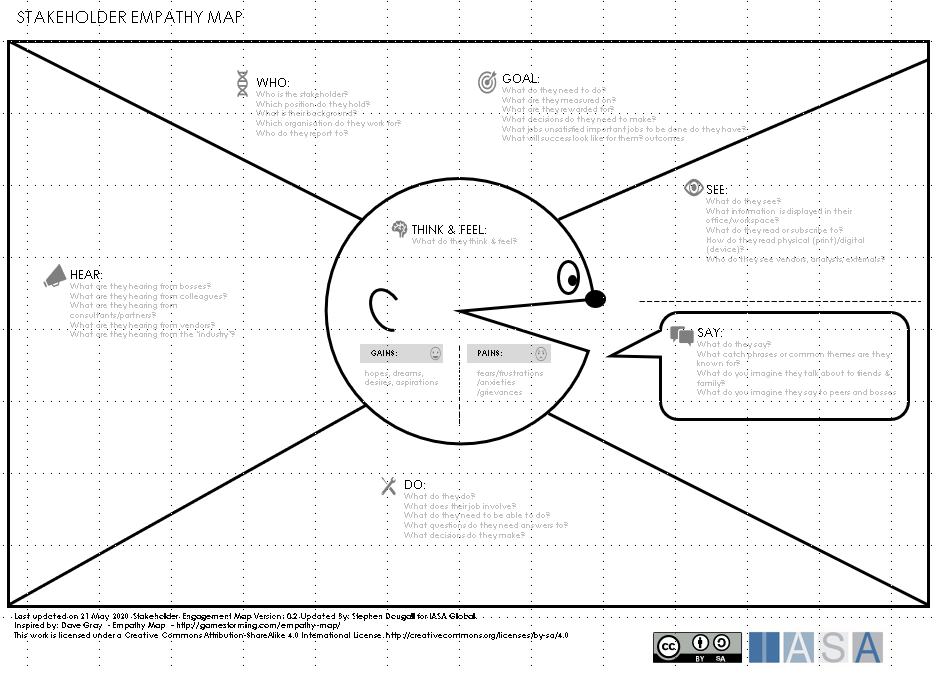
Step 3: Put yourself in the stakeholder’s shoes
Using the context, the participants can try to place themselves in the stakeholder position and consider the following:
- Think and Feel – what does the stakeholder think and feel about the context? Worried, happy, excited, defensive.
- Hear – what does the stakeholder hear about the context? For example, from friends, colleagues, managers.
- See – what does the stakeholder see about the context? Written or visual communications. Work environment.
- Say – what does the stakeholder say about the context? Positively promote, voice concerns.
- Do – what does the stakeholder do about the context? Active involvement, try to block, positioning.
- Pains – what does the stakeholder stand to lose from the context? Large investment, loss of skills/personnel, damaged relationships, risk.
- Gains – what does the stakeholder stand to gain from the context? Prestige, financing, knowledge, favors, power.
The result of working with the empathy map is in the process, being placed in the stakeholder situation with the given context leads to a deeper understanding of the stakeholder. This can be used to assess how to engage the stakeholder and positively motivate them. This may involve a re-assessment of the communication strategy or perhaps change proposals which influence the stakeholder positively.
Communication Strategies
Stakeholders have different needs for information, and the architect will prioritize stakeholders differently. It is important that the stakeholders receive information that satisfies their needs, and at the same time the architect distributes effort effectively across the stakeholders.
A communication strategy is used as a plan to organize the distribution of information and plan consultation with stakeholders. A communication strategy can be organized into a number of communication methods. The communication method provides a channel for providing information and consultation to stakeholders. Examples of different communication methods are:
- Reference groups
- Steering groups
- Re-occurring meetings
- E-mail, newsletters
- On-line conferences
A communication method also has a format. The format may describe the subject of the communication, how often the communication occurs and communication type (information, consulting, decisions…).
Each communication method will also have a list of stakeholders whose needs will be fulfilled by the communication method. The same stakeholder may be present in a number of communication methods.
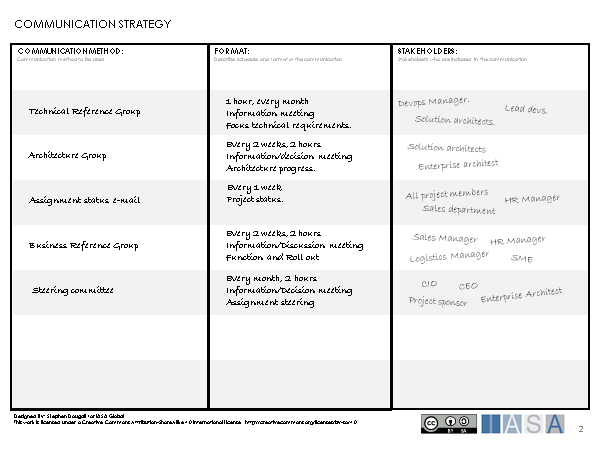
The canvas above shows an example of a communication strategy. There are different ways to work with this canvas, sometimes the stakeholders may be filled in and then communication method defined, or some communication methods can be defined first and then stakeholders assigned. The priority of the stakeholder is an important factor in determining the communication methods to be used.
Once the communication strategy is complete it can be implemented and then revisited as the stakeholder ecosystem changes. The communication strategy gives a practical plan for managing stakeholder communication.
References and further reading
Dave Gray – Empathy Map
http://gamestorming.com/empathy-map/
TOGAF 9: Stakeholder Management
https://pubs.opengroup.org/architecture/togaf9-doc/m/chap21.html

BTABoK 3.0 by IASA is licensed under a Creative Commons Attribution-NonCommercial 4.0 International License. Based on a work at https://btabok.iasaglobal.org/







